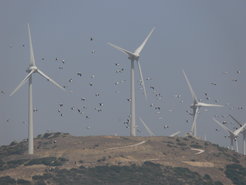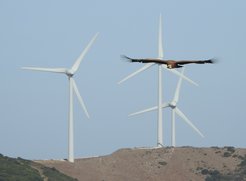Flying into a clean and safe future
A pair of GPS studies brings clarity to a burning climate question: can wind turbines and migrating birds coexist?
In the race to avoid runaway climate change, two renewable energy technologies are being pushed as the solution to powering human societies: wind and solar. But for many years, wind turbines have been on a collision course with wildlife conservation. Birds and other flying animals risk death by impact with the rotor blades of turbines, raising questions about the feasibility of wind as a cornerstone of a global clean energy policy. Now, a pair of animal tracking studies from the Max Planck Institute of Animal Behavior and the University of East Anglia, UK, has provided detailed GPS data on flight behavior of birds that are susceptible to collision with energy infrastructure. The first, a large-scale study of 1,454 birds from 27 species, has identified hotspots in Europe where birds are particularly at risk from wind turbines and power lines. The second zoomed in on how birds behave when flying near turbines, revealing that individuals will actively avoid turbines if they are within one kilometer. By tracking the movement of birds with high precision GPS devices, both studies provide the detailed biological data needed to expand renewable energy infrastructure with minimal impacts to wildlife.

Wind energy generation has been increasing over the past two decades with the global commitment to transition to renewable energy from carbon-emitting fossil fuels. European onshore wind energy capacity is projected to grow nearly fourfold by 2050, and countries in the Middle East and North Africa, such as Morocco and Tunisia, also have targets to increase the share of electricity supply from onshore wind.
"We know from previous research that there are many more suitable locations to build wind turbines than we need in order to meet our clean energy targets up to 2050," said Jethro Gauld, lead author on the Journal of Applied Ecology paper and a PhD researcher in the School of Environmental Sciences at University of East Anglia (UEA).
"If we can do a better job of assessing risks to biodiversity, such as collision risk for birds, into the planning process at an early stage we can help limit the impact of these developments on wildlife while still achieving our climate targets.”
Pinpointing collision hotspots in Europe
An international team of 51 researchers from 15 countries, including the Max Planck Institute of Animal Behavior (MPI-AB) in Germany, collaborated to identify the areas where these birds would be more sensitive to onshore wind turbine or power line development. The study, published in Journal of Applied Ecology, used GPS location data from 65 bird tracking studies to understand where they fly more frequently at danger height—defined as 10-60 meters above ground for power lines and 15-135 meters for wind turbines.
“GPS tracking provides very accurate data on location and flight height, which cannot be obtained from direct observation, particularly from large distances,” says Martin Wikelski, director at the MPI-AB and co-author on the study. The study represents the first time GPS data from so many species has been pooled to create a comprehensive picture of where birds are at risk.
The resulting vulnerability maps reveal that the collision hotspots are particularly concentrated within important migration routes, along coastlines and near breeding locations. These include the Western Mediterranean coast of France, Southern Spain and the Moroccan Coast—such as around the Strait of Gibraltar—Eastern Romania, the Sinai Peninsula and the Baltic coast of Germany.
The GPS data collected related to 1,454 birds from 27 species, mostly large soaring ones such as white storks. Exposure to risk varied across the species, with the Eurasian spoonbill, European eagle owl, whooper swan, Iberian imperial eagle and white stork among those flying consistently at heights where they risk collision.
The authors say development of new wind turbines and transmission power lines should be minimized in these high sensitivity areas, and any developments which do occur will likely need to be accompanied by measures to reduce the risk to birds.
How birds behave near turbines
As well as providing location and flight height, GPS loggers open up an additional frontier in efforts to better plan energy infrastructure.
“With GPS tracking we are able to understand exactly how birds behave as they fly close to the turbines,” says Carlos Santos, an Affiliated Scientist of MPI-AB and an Assistant Professor at the Federal University of Pará, in Brazil. “Knowing how close they fly, and whether or not wind or other factors influence their flight behavior, is very important to mitigate collision rates as it can help better planning of wind farms.”

A team of scientists from MPI-AB and UEA focused their attention on the black kite, a very common soaring bird that migrates through the Strait of Gibraltar, the narrow straight between southern Spain and North Africa. “The Strait of Gibraltar is the main migratory bottleneck for birds in western Europe but it’s also a hotspot for wind farms,” says Santos. “We wanted to see how soaring birds behave in this area, which represent a serious threat during their migration to Africa. According to collision estimates from another study and the number of turbines currently operating in the region of Tarifa, we expect that more than a hundred griffon vultures die every year as well as tens of short-toed snake eagles and common kestrels. These are the soaring bird species that most die due to collision with wind turbines in this region.”
This study, published in Scientific Reports, looked at GPS information from 126 black kites as the birds approached wind turbines. The data showed that birds avoided flight paths straight to turbines as they flew closer to them. The birds started to deviate from turbines one kilometer away, but this effect was even more pronounced within 750 meters and when the wind was blowing towards the turbines. “This means that they recognize the risk of the turbines and keep a safe distance from them,” says Santos who was lead author on the Scientific Reports study.
The authors say collecting GPS data from the interaction between birds and turbines is extremely difficult. Says Santos: “You need to tag many animals to increase the chances of recording their behavior near the turbines. This is why our dataset is so uncommon. Fortunately, GPS tracking studies are becoming more common and hopefully in the near future we will be able to gather data of this sort for other soaring bird species.”
The authors stress that understanding how the birds perceive wind turbines and which factors attenuate or exacerbate their perception is critical to learn where to place turbines and to develop effective deterrents.













